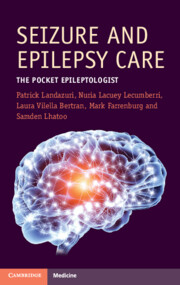Book contents
- Seizure and Epilepsy Care
- Seizure and Epilepsy Care
- Copyright page
- Contents
- 1 How Do I Evaluate a First-Time Seizure?
- 2 How Do I Make an Epilepsy Diagnosis?
- 3 Which Antiseizure Medicines Treat Epilepsy and How Do I Pick?
- 4 How Can I Best Use EEG for Treating Epilepsy Patients?
- 5 What Are Common Epilepsy Imaging Findings in New Onset and Chronic Epilepsy Care?
- 6 How Do I Care for Patients in the Emergency Department and Inpatient Settings?
- 7 How Do I Manage Epilepsy Emergencies Like Status Epilepticus?
- 8 What Is the Best Long-Term Treatment Plan for Epilepsy Patients as an Outpatient?
- 9 What to Do When Your Patient Fails Two Antiseizure Medicines
- 10 Nonepileptic Events and General Psychiatric Care for Epilepsy Patients
- 11 What Are Essential Pediatric Epilepsy Clinical Diagnoses and Treatment Plans?
- Index
- References
6 - How Do I Care for Patients in the Emergency Department and Inpatient Settings?
Published online by Cambridge University Press: 28 January 2023
- Seizure and Epilepsy Care
- Seizure and Epilepsy Care
- Copyright page
- Contents
- 1 How Do I Evaluate a First-Time Seizure?
- 2 How Do I Make an Epilepsy Diagnosis?
- 3 Which Antiseizure Medicines Treat Epilepsy and How Do I Pick?
- 4 How Can I Best Use EEG for Treating Epilepsy Patients?
- 5 What Are Common Epilepsy Imaging Findings in New Onset and Chronic Epilepsy Care?
- 6 How Do I Care for Patients in the Emergency Department and Inpatient Settings?
- 7 How Do I Manage Epilepsy Emergencies Like Status Epilepticus?
- 8 What Is the Best Long-Term Treatment Plan for Epilepsy Patients as an Outpatient?
- 9 What to Do When Your Patient Fails Two Antiseizure Medicines
- 10 Nonepileptic Events and General Psychiatric Care for Epilepsy Patients
- 11 What Are Essential Pediatric Epilepsy Clinical Diagnoses and Treatment Plans?
- Index
- References
Summary
A common care location for seizure and epilepsy patients is the emergency department and inpatient setting. A thorough history to discern a specific diagnosis and localization guides testing and treatment decisions. These decisions include the need for additional imaging/laboratory testing and whether to start an antiseizure medicine (ASM). Electroencephalograms (EEGs) are often required with time length depending on clinical question. If an epilepsy diagnosis is certain without clear localization, one hour of testing is preferred. If the question (or diagnosis) is status epilepticus, 24-hour EEG is indicated. For patients with known epilepsy, ASM alteration can occur for seizures with appropriate compliance. If there is noncompliance, an ASM increase may not be required. The perioperative period requires ASM continuation, although the administration route may change. Patients with renal or hepatic impairment often necessitate dose adjustment. Specific situations like alcohol withdrawal seizures have accepted paradigms to follow and are discussed. Lastly, patients in epilepsy monitoring units (EMUs) are hospitalized for diagnostic reasons with management needs different than other epilepsy patients.
- Type
- Chapter
- Information
- Seizure and Epilepsy CareThe Pocket Epileptologist, pp. 102 - 128Publisher: Cambridge University PressPrint publication year: 2023

